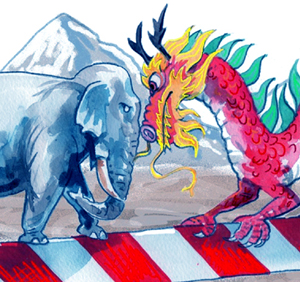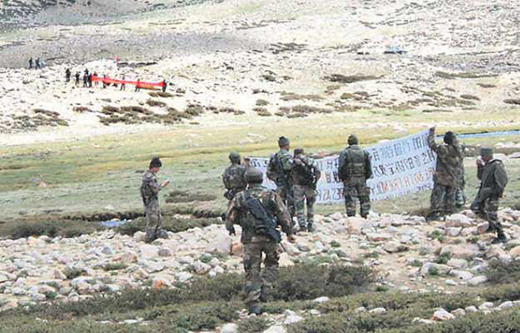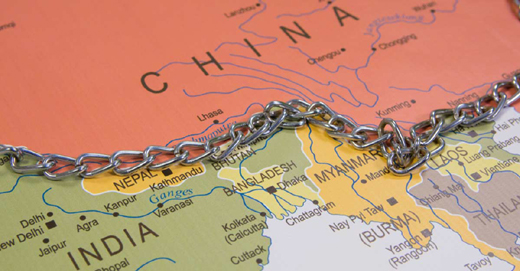Indian Elephant dominates Chinese Dragon
Indian Elephant dominates Chinese Dragon
Mangalore Today News Network
By Kumar Ramesh New Delhi, June 19, 2020: After 58 years, the borders are bled again and conditions remain fragile. Since both countries do not want to go into direct war, therefore, military and diplomatic negotiations continue but China’s threat is not ending. Recently Chinese mouthpeace Global Times is saying that Pakistan and Nepal are with us and India will lose in the event of war that is, indirectly China has been threatening India on three fronts war. At the same time, it is also saying that 17 wounded Indian soldiers were killed due to lack of timely rescue operations, which shows that the Indian Army has serious shortcomings in providing emergency medical care to the injured and is not an army with real modern combat capabilities on the plateau. Apart from this, we have prevented the information about the damage done on the Chinese side for the good of India because it can provoke the sentiments of Chinese people who would like to take revenge from India. All this is happening when China is facing pressure in the case of coronavirus and South China Sea and on the other hand India is becoming a temporary member of the UN Security Council.
New Delhi, June 19, 2020: After 58 years, the borders are bled again and conditions remain fragile. Since both countries do not want to go into direct war, therefore, military and diplomatic negotiations continue but China’s threat is not ending. Recently Chinese mouthpeace Global Times is saying that Pakistan and Nepal are with us and India will lose in the event of war that is, indirectly China has been threatening India on three fronts war. At the same time, it is also saying that 17 wounded Indian soldiers were killed due to lack of timely rescue operations, which shows that the Indian Army has serious shortcomings in providing emergency medical care to the injured and is not an army with real modern combat capabilities on the plateau. Apart from this, we have prevented the information about the damage done on the Chinese side for the good of India because it can provoke the sentiments of Chinese people who would like to take revenge from India. All this is happening when China is facing pressure in the case of coronavirus and South China Sea and on the other hand India is becoming a temporary member of the UN Security Council.
But will all this stop here! Indian Foreign Minister Dr. S. Jaishankar told his Chinese counterpart Wang Yi that China was responsible for whatever happened on the border and that the move was pre-planned and deliberate, which would have a serious impact on bilateral relations. At present, the situation in the Galvan Valley remains the same, but this is the sixth time India has faced the invasion of China. Beginning of course in 1962, China attacked the Gorkha post here, 1383 Indian soldiers were martyred in this battle, 1696 missing and 3968 soldiers were taken captive, while 722 Chinese soldiers were killed. After this, China annexed Aksai China, which continues to this day, the Galvan Valley is located in this region. Then in 1967 the two armies came face to face near the Sikkim border, the confrontation started when a wire was mapped in India from Nathu La to Cebu La, the old Gangtok-Yatung-Lhasa road passes through this area. During the Indo-Pakistan War of 1965, China asked India to vacate the Nathu La and Jalep La Pass, India emptied the Jalep La Pass but the situation at Nathu La Pass remained the same. Since then Nathu La became the center of controversy and there was a confrontation between the armies. A few days later, China attacked Indian soldiers with machine guns and India retaliated in the Cho La area with the soldiers retaining their positions, 80 Indian soldiers were martyred while 400 Chinese soldiers died.

China was never able to digest this 1967 defeat, so in 1975 it attacked the Patrolling Party of Assam Rifles at Tulung La in Arunachal Pradesh, in which four of our soldiers were martyred. A fourth confrontation took place again between the two armies at Tawang in Arunachal Pradesh in 1987, in the Samdorang Chu area north of Tawang. The Indian Army was stationed in the south of Namka Chu but an IB team reached Samdorang Chu. This place is on the other side of Nayamjung Chu, both the Samdorang Chu and Namka Chu streams into the Nayamjung Chu River. It happened that in 1985 the Indian Army stayed here for the entire summer but when it arrived in the summer of 1986, the Chinese army was present here and had buried their tents in Samdorang Chu. It happened that in 1985 the Indian Army stayed here for the entire summer but when it arrived in the summer of 1986, the Chinese army was present here and had buried their tents in Samdorang Chu. When the Chinese army did not listen even after much persuasion, the Indian Army launched Operation Falcon and airlifted the soldiers to the disputed place. The troops held positions here on the Hathung La hill from where three more hill areas could be monitored along with Samdoi Chu, in a few days the Indian Army was deployed from Ladakh to Sikkim and soon the situation was brought under control. The last time both armies stood face-to-face for 75 days in Doklam in 2017, this area of the disputed hill, on which both China and Bhutan claim their claim. India supports Bhutan’s claim on this. In June, when China started road construction here, it was stopped forcefully by Indian troops. India’s argument was that the construction of the road can change its security equation, which Chinese soldiers can use to occupy the Siliguri corridor of India. However there was no violence and the matter was settled peacefully.
To avoid these circumstances, former Indian Prime Minister PV Narasimha Rao visited China in 1993, and signed the Maintenance of Peace and Tranquility Agreement with Chinese Premier Li Peng. The agreement was to restore peace on the LAC, which was laid during Prime Minister Rajiv Gandhi’s 1988 visit to China, which included five principals. After that, Chinese President Jiang Zemin visited India in 1996, then the Confidence Building Measures in Military Fields agreement was signed with the Prime Minister HD Deve Gowda. Similarly, in 2003, the Atal Bihari Vajpayee government prepared a special representative level mechanism on the border dispute. Then Manmohan Singh made three agreements in 2005, 2012 and 2013 to increase talks on border dispute with China, at that time the current foreign minister S. Jaishankar was India’s ambassador to China. But since Narendra Modi became the Prime Minister till date, he is the most visited Prime Minister to visit China for 5 times and the most frequently to meet the Chinese President 18 times. He left no such thing to build confidence, yet this incident happened.

The present situation is critical, the Indian Prime Minister has also given the army an open leeway to respond to the provocation, as well as preparations are being made to impose harsh economic sanctions. But the most important thing is why this confrontation started. India has constructed a road from the Shyok River to Darbok, which is now being extended to Daulat Beg Oldi, 255 km away. China is aggressive about this construction because it fears that once the road is built, India will have easy access to the Siachen and Karakoram passes, making it difficult to surround India later. India will begin destabilizing Xinjiang province in the future, as well as affecting the Belt and Road project originating from Kashgar. China is also afraid that India will not join any alliance in the South China Sea with the United States, so China was constantly under pressure on India, but the way Indian soldiers have responded to the Chinese troops without arms, Superpower China had never imagined it in today’s century. His pressure backfired on him as the Chinese President is already engulfed in many matters; his wind of power is poised to become a storm, so these actions were carried out to save his face. At present, the world is closely watching these skirmishes, but the Indian response in this skirmish has given a new lease of life to many countries of the world like Vietnam, Taiwan, Philippines, Indonesia, Japan, Australia and Tibet; now they are also feeling capable of retaliating China, this thing has brought China under more pressure, so it is engaged in threatening India again and again.
However, one thing is clear that this tension will not end any more with any magic because both countries have suffered a lot. The Indian Army has increased its movement on Ladakh and other borders, declaring an alert in Lahaul Spiti and Kinnaur districts of Himachal Pradesh. The units of the army which were about to return to the Peace Station have been asked to stop there. Preparations have begun to evacuate the border villages in Ladakh, mobile and landline phones have been closed. The soldiers’ leave has been canceled and orders have been given to take immediate action on any Chinese action. In addition, the Navy has also received orders to deploy its warships in areas adjacent to China and the Air Force has also increased deployment of fighter jets at its forward bases in Himachal and Uttarakhand. So we will see what the picture of the future will be, because amidst the India-China tension, all three of his army chiefs in Pakistan are also reaching the ISI headquarters and are engaged in strategizing.
The writer is a PhD Research Scholar in Criminology and Foreign Affairs Analyst. He can be reached at: kumar.ramesh0@yahoo.com
- Need For ‘Students, Alcohol and Drugs’ survey
- New Synthetic Drugs Trapping Youth
- Mood Modifying Chips - Future of Drug Use
- Ramping up Indo-Bangla border security
- IITM- A premier educational Institution in a forest. What can we learn?
- Former PM, Manmohan Singh: Notable laws passed under his tenure
- Hashish on Ratnagiri Seashore
- The Poor cry out to Us: Do we respond?
- Clandestine Meth Labs Sprouting Across India
- Hydro ganja from Bangkok latest craze among youth in India
- "Memories to Treasure" Dr.Michael Lobo’s new book
- Dominance of Private Universities: Will it make education inaccessible to underprivileged students?
- Monti Phest: A rich heritage of South Canara
- Kashmir Bhavan in Bengaluru: A must visit place
- "MAI and I" Book of Angelic Emotions
- Draupadi Murmu - The New ’President of India’
- Anthony Ashram in the city grows a classic museum
- First College of Fisheries in India - A Golden Jubilarian
- Flushing Meadows - A Vintage Mansion
- The Colonel�s Bequest
- A Mangalorean PM and his RBI Governor Brother: The Extraordinary story of the Benegal Brothers
- There is no higher religion than Truth: Theosophical Society
- L�affaire - Ashu & Yiju of Mangalore
- Mangalore in Kowloon
- 1568 to 2018 AD: 450 years of Christianity in Mangaluru
- Vice President elect Naidu moves on from nadir to zenith, the phenomenal journey
- Embracing the Outdoors: How Heated Jackets Are Revolutionizing Cold Weather Activities
- Efficient and Sustainable Packaging Solutions with FIBCs
- The Hybrid Kilt Revolution | Where Tradition Gets Trendy
- Affordable Elegance | Embrace Style on a Budget with Cheap Kilts
- Unleashing Style and Functionality | Exploring Tactical Kilts
- Mangalore’s Heroic Lady marks 105th Birthday
- Santa the Christmas spirit
- Geriatric care: Mangalore strikes a fine balance
- The Don Who Made Two Empires to Clash
- CHITRAPUR SARASWATS - A Great Kanara Community
- Our new President Ram Nath Kovind’s significant journey to Rashtrapathi Bhavan
- Marriages made in heaven, big fat weddings made in India
- Eid insight - The giver of glad tidings
- CITY INFORMATION
- TRAVEL
- TOURIST INFORMATION
- HEALTH CARE
- MISCELLANEOUS




 Write Comment
Write Comment E-Mail To a Friend
E-Mail To a Friend Facebook
Facebook Twitter
Twitter  Print
Print 


